Chapter 4: Sample Exercises - Balance
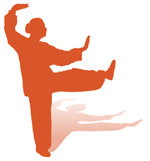 Lian, age 68, has found that regular tai chi classes have improved her balance and flexibility:
Lian, age 68, has found that regular tai chi classes have improved her balance and flexibility:
“Early every morning, I join a group of my neighbors, and we practice tai chi for about an hour. We start out with a gentle warm-up and breathing exercises. Then our teacher shows us how to do certain poses and leads us step by step through the slow, flowing movements. We end with cooling down exercises. This exercise routine has boosted my confidence and reduced my fear of falling. It also keeps my arthritis under control.”
|

You’re walking in the neighborhood and you hear a bicycle bell behind you. Knowing you can turn around quickly and move out of the way without losing your balance is a great feeling!
|
 How to Improve Your Balance
How to Improve Your Balance
Each year, more than 1.6 million older Americans go to the emergency room because of fall-related injuries. A simple fall can cause a serious fracture of the arm, hand, ankle, or hip. Balance exercises can help you prevent falls and avoid the disability that may result from falling.
How Much, How Often
You can do the balance exercises in this section as often as you like. They overlap with the lower-body strength exercises, which also can improve your balance. Do the strength exercises 2 or more days per week, but not on any 2 days in a row.
Safety
- Have a sturdy chair or a person nearby to hold on to if you feel unsteady.
- Talk with your doctor if you are unsure about doing a particular exercise.
Progressing
These exercises can improve your balance even more if you modify them as you progress. Start by holding on to a sturdy chair for support. To challenge yourself, try holding on to the chair with only one hand; then with time, you can try holding on with only one finger, then no hands. If you are steady on your feet, try doing the exercise with your eyes closed. You can use the Strength and Balance Daily Record in Chapter 7 to keep track of your balance exercises.
Anytime, Anywhere Balance Exercises
You can do exercises to improve your balance almost anytime, anywhere, and as often as you like, as long as you have something sturdy nearby to hold on to if you become unsteady. In the beginning, using a chair or the wall for support will help you work on your balance safely.
| Stand on One Foot |
You can do this exercise while waiting for the bus or standing in line at the grocery. For an added challenge, you can modify the exercise to improve your balance. |
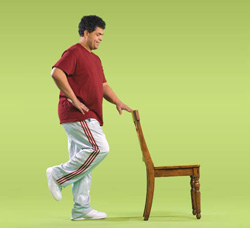 |
- Stand on one foot behind a sturdy chair, holding on for balance.
- Hold position for up to 10 seconds.
- Repeat 10-15 times.
- Repeat 10-15 times with other leg.
- Repeat 10-15 more times with each leg.
| |
| Heel-to-Toe Walk |
Having good balance is important for many everyday activities, such as going up and down stairs. |
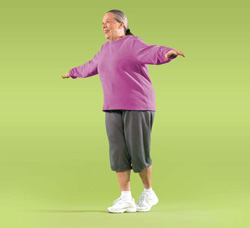 |
- Position the heel of one foot just in front of the toes of the other foot. Your heel and toes should touch or almost touch.
- Choose a spot ahead of you and focus on it to keep you steady as you walk.
- Take a step. Put your heel just in front of the toe of your other foot.
- Repeat for 20 steps.
|
 |
If you are unsteady on your feet, try doing this exercise near a wall so you can steady yourself if you need to. | |
| Balance Walk |
Good balance helps you walk safely and avoid tripping and falling over objects in your way. |
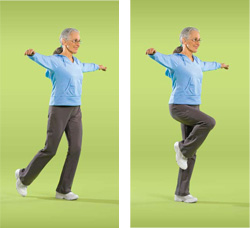 |
- Raise arms to sides, shoulder height.
- Choose a spot ahead of you and focus on it to keep you steady as you walk.
- Walk in a straight line with one foot in front of the other.
- As you walk, lift your back leg. Pause for 1 second before stepping forward.
- Repeat for 20 steps, alternating legs.
|
 |
As you progress, try looking from side to side as you walk, but skip this step if you have inner ear problems. | |
Progressing to Improve Balance
The exercises in this guide — especially those to strengthen your legs and ankles — can help improve your balance. As you progress, try adding the challenges shown below to help even more. For example, start by holding on to a sturdy chair with both hands for support. To challenge yourself further, try holding on to the chair with only one hand. As you feel steady, try using just one finger to balance you. Then, try balancing without holding on. When you are steady on your feet, try doing the exercises with your eyes closed. You can use these modifications with the following exercises:
Back Leg Raise
Side Leg Raise
Knee Curl
Toe Stand
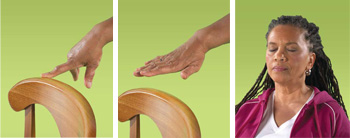
|
<<Back | Next >>
